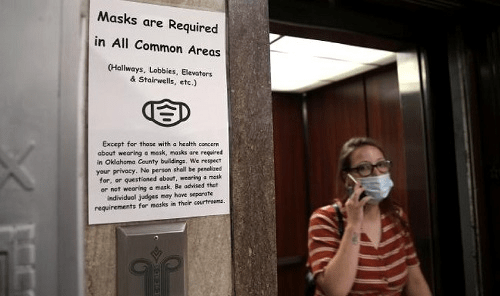
8.23.20 – The Oklahoman
Early indicators show the face mask mandates adopted by some Oklahoma localities to reduce the spread of COVID-19 are working.
Data from the Oklahoma State Department of Health shows cities with mask mandates nearly cut in half their average number of new COVID-19 infections after three weeks.
On July 20, the rolling average of new COVID-19 cases in cities with mask ordinances was 457. By Aug. 12, that number had dropped 47% to 233.
Areas without mask ordinances also saw a 28% drop in new COVID-19 cases during the same time period. That drop was likely due, in part, to some Oklahomans wearing face masks even where they aren’t required.
The state data was provided to a Republican state legislator after he asked for information about whether Oklahoma’s mask mandates are working.
“Implementation of mask mandates — and general utilization of masks, even absent a mandate — would indeed be expected to protect others and eventually reduce infection rates everywhere and for everyone, even those not utilizing masks,” Interim State Epidemiologist Jared Taylor said in a statement.
The recent Public Health Advisory issued by Oklahoma’s Interim Health Commissioner Lance Frye stemmed from data showing face coverings reduce the spread of transmission in heavily populated areas, said Health Department spokesman Rob Crissinger.
The advisory recommends Oklahomans ages 11 and older in orange or red counties should wear face coverings in public settings. As of Friday, 30 of Oklahoma’s 77 counties were classified as orange, or at moderate risk, according to the state’s color-coded COVID-19 alert system.
In Oklahoma, 17 localities have adopted mask ordinances, according to data compiled by the Oklahoma State Medical Association. That includes some localities, like The Village and Warr Acres, which are also a part of Oklahoma City. Ordinances in two cities — Choctaw and Edmond — have not yet taken effect. A mandate in McAlester took effect Thursday.
Anadarko was an early adopter of a mask ordinance, implementing such a requirement back in April when the state was still trying to “flatten the curve.”
On July 8, Norman kicked off a series of cities imposing mask ordinances. Tulsa, Oklahoma City, Stillwater, Altus, Anadarko and Lawton were quick to follow.
In some instances, critics of the mandates have challenged the ordinances through legal means. A federal lawsuit challenging Tulsa’s mask mandate was filed this week.
A group in Stillwater is exploring the possibility of recalling the entire city council, in part because of an ordinance requiring face coverings be worn in public.
OU Medicine’s Dr. David Kendrick said he’s also seeing indications that local mask mandates are reducing the COVID-19 positivity rate, or the percentage of COVID-19 tests that are positive.
Kendrick, who doubles as the CEO of the Oklahoma’s nonprofit health information exchange MyHealth Access Network, compared municipalities that adopted mask policies versus those that didn’t using MyHealth data.
He looked at six cities, including Oklahoma City and Tulsa, that have adopted mask ordinances. Roughly 1.3 million of Oklahoma’s 3.9 million residents live in the areas he looked at that have mandated masks.
In the first seven days after a mask policy went into effect, the positivity rate dropped by 0.47%. After 14 days, the positivity rate dropped by 7.57% and by 21 days, it had decreased by 5.73%.
“Masks are an important component of our response as a society and a state, and I think they’re with us for a while,” Kendrick said.
Masking policies aren’t perfect, he said. Just because a city has a mask policy doesn’t mean everyone adheres to the mandate.
On the other hand, there are people who adopt wearing a face mask in public before any formal mandate is in place, Kendrick said, citing the Health Department’s efforts to encourage Oklahomans to wear a mask.
More data will allow researchers to see the trends of mask mandates more clearly, he said. All of Oklahoma’s local mask mandates have been in effect for less than two months.
“They’re absolutely working,” State Medical Association President Dr. George Monks said of mask mandates. “We knew it was going to take two or three weeks for them to really start having an effect because that’s just the lag time between infections and when people get sick.”
Noting less than half of the state’s population is covered by a local mask ordinance, Monks reiterated his call for Gov. Kevin Stitt to implement a statewide mask mandate. Statewide mask policies are in place in effect in five of Oklahoma’s neighboring states, Monks said.
The most recent report from the White House Coronavirus Task Force shows Oklahoma as one of nine states in “red zone” for high per-capita infection rates, and recommends Oklahoma implement a statewide mask mandate.https://9f34aac0bcd0ca0fb9b94e856543e254.safeframe.googlesyndication.com/safeframe/1-0-37/html/container.html
The governor has resisted calls for such a policy, saying he can’t fathom how it would be enforced. On Friday, Stitt pointed to the Public Health Advisory that currently recommends people in more than one-third of Oklahoma’s counties wear a mask in public settings.
